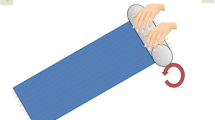Abstract
Molecular statics and molecular dynamics are employed to study the effects of various microstructural and topological defects (e.g., chain ends, axial chain misalignment, inorganic solvent impurities, and sheet stacking faults) on the strength, ductility, and stiffness of p-phenylene terephthalamide (PPTA) fibers/filaments. These fibers can be considered as prototypes for advanced high strength/high-stiffness fibers like Kevlar®, Twaron®, New Star®, etc. While modeling these fibers, it was taken into account that they are essentially crystalline materials consisting of stacks of sheets, with each sheet containing an array of nearly parallel hydrogen-bonded molecules/chains. The inter-sheet bonding, on the other hand, was considered as mainly being of van der Waals or p-electron character. The effects of various deviations of the PPTA fiber structure from that of the perfectly crystalline structure (i.e., microstructural/topological defects) on the material’s mechanical properties are then considered. The results obtained show that while the presence of these defects decreases all the mechanical properties of PPTA fibers, specific properties display an increased level of sensitivity to the presence of certain defects. For example, longitudinal tensile properties are found to be most sensitive to the presence of chain ends, in-sheet transverse properties to the presence of chain misalignments, while cross-sheet transverse properties are found to be most affected by the presence of sheet stacking faults.










Similar content being viewed by others
References
M. Grujicic, B. Pandurangan, K.L. Koudela, and B.A. Cheeseman, A Computational Analysis of the Ballistic Performance of Light-Weight Hybrid-Composite Armor, Appl. Surf. Sci., 2006, 253, p 730–745
M. Grujicic, T. He, H. Marvi, B.A. Cheeseman, and C.-F. Yen, A Comparative Invesigation of the Use of Laminate-Level Meso-Scale and Fracture-Mechanics Enriched Meso-Scale Composite-Material Models in Ballistic Resistance Analyses, J. Mater. Sci., 2010, 45(12), p 3136–3150
M. Grujicic, D.C. Angstadt, Y.-P. Sun, and K.L. Koudela, Micro-Mechanics Based Derivation of the Materials Constitutive Relations for Carbon Nanotube Reinforced Poly-Vinyl-Ester-Epoxy Based Composites, J. Mater. Sci., 2007, 42, p 4609–4623
M. Grujicic, G. Arakere, T. He, M. Gogulapati, and B.A. Cheeseman, A Numerical Investigation of the Influence of Yarn-Level Finite-Element Model on Energy Absorption by a Flexible-Fabric Armor During Ballistic Impact, J. Mater. Des. Appl., 2008, 222, p 259–276
M. Grujicic, W.C. Bell, G. Arakere, T. He, X. Xie, and B.A. Cheeseman, Development of a Meso-Scale Material Model for Ballistic Fabric and Its Use in Flexible-Armor Protection Systems, J. Mater. Eng. Perform., 2010, 19–1, p 22–39
M. Grujicic, W.C. Bell, T. He, and B.A. Cheeseman, Development and Verification of a Meso-Scale Based Dynamic Material Model for Plain-Woven Single-Ply Ballistic Fabric, J. Mater. Sci., 2008, 43, p 6301–6323
B.A. Cheeseman, C.F. Yen, B.R. Scott, B. Powers, T.A. Bogetti, B. LaMatina, Y. Duan, M. Keefe, Y. Miao, and Y. Wang, “From Filaments to Fabric Packs—Simulating the Performance of Textile Protection Systems,” ARL Report ADM002075, 2006
G.C. Rutledge and U.W. Suter, Detailed Atomistic Simulations of Oriented Pseudocrystalline Polymers and Applications to a Stiff Chain Aramid, Macromolecules, 1991, 24, p 1924–1933
H.G. Chae and S. Kumar, Making Strong Fibers, Science, 2008, 319, p 908–909
V.B. Gupta and V.K. Kothari, Manufactured Fibre Technology, Chapman & Hall, New York, 1997
M. Panar, P. Avakian, R.C. Blume, K.H. Gardner, T.D. Gierke, and H.H. Yang, Morphology of Poly(p-phenylterepthalamide) Fibers, J. Polym. Sci., 1983, 21, p 1955–1969
H. Sun, COMPASS: An Ab Initio Force-Field Optimized for Condensed-Phase Applications-Overview with Details on Alkane and Benzene Compounds, J. Phys. Chem. B., 1998, 102, p 7338
H. Sun, P. Ren, and J.R. Fried, The Compass Force Field: Parameterization and Validation for Phosphazenes, Comput. Theor. Polym. Sci., 1998, 8(1/2), p 229
M. Grujicic, Y.P. Sun, and K.L. Koudela, The Effect of Covalent Functionalization of Carbon Nanotube Reinforcements on the Atomic-Level Mechanical Properties of Poly-vinyl-ester-epoxy, Appl. Surf. Sci., 2007, 253(2007), p 3009
G.C. Rutledge and U.W. Suter, Calculation of Mechanical Properties of Poly(p-phenylene terephthalamide) by Atomistic Modelling, Polymer, 1991, 32, p 12
Acknowledgments
The material presented in this article is based on study supported by the Army Research Office (ARO) research contract entitled “Multi-length Scale Material Model Development for Armor-grade Composites,” Contract Number W911NF-09-1-0513, and the Army Research Laboratory (ARL) research contract entitled “Computational Analysis and Modeling of Various Phenomena Accompanying Detonation Explosives Shallow-Buried in Soil” Contract Number W911NF-06-2-0042. The authors are indebted to Bruce LaMattina of ARO for his continuing support and interest in this study.
Author information
Authors and Affiliations
Corresponding author
Rights and permissions
About this article
Cite this article
Grujicic, M., Bell, W.C., Glomski, P.S. et al. Filament-Level Modeling of Aramid-Based High-Performance Structural Materials. J. of Materi Eng and Perform 20, 1401–1413 (2011). https://doi.org/10.1007/s11665-010-9786-y
Received:
Published:
Issue Date:
DOI: https://doi.org/10.1007/s11665-010-9786-y




